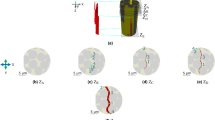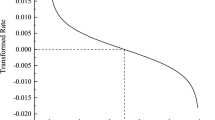Abstract
WE have measured values of the fracture surface energy (γ) at + 20° C of a sample of high molecular weight poly(methyl methacrylate) sheet (‘Perspex’, manufactured by Imperial Chemical Industries, Ltd., Plastics Division). In order to measure γ over a wide range of crack propagation velocities (ċ), we used three different experimental techniques: (1) A modification of the static loading method described by Van den Boogaart and Turner1 in which the crack length was measured as a function of time. From the results it was possible to deduce the relation between γ and ċ by assuming a value for Young's modulus (E = 2.85 × 1010 dynes/cm2). This technique covered the range of velocities from comparatively slow rates (≃ 10−4 cm/sec) up to about 1 cm/sec. Beyond this the crack propagation rate increased rapidly and the specimen failed catastrophically. (2) A modification of the cleavage technique described by Broutman and McGarry2 which produced controlled crack growth at various lead screw speeds. (3) Charpy impact tests on sharply notched specimens. γ was taken as the ratio of the energy to break to the area of the new surfaces created during crack growth. Although ċ was not measured accurately, it is between the pendulum velocity at the point of impact (240 cm/sec) and tho maximum possible crack propagation velocity (∼ 105 cm/sec). Thus it is substantially higher than in the other experiments.
This is a preview of subscription content, access via your institution
Access options
Subscribe to this journal
Receive 51 print issues and online access
$199.00 per year
only $3.90 per issue
Buy this article
- Purchase on SpringerLink
- Instant access to full article PDF
Prices may be subject to local taxes which are calculated during checkout
Similar content being viewed by others
References
Van den Boogaart, A., and Turner, C. E., Trans. J. Plast. Inst., 31, 109 (1963).
Broutman, L. J., and McGarry, F. J., J. App. Polymer Sci., 9, 589 (1965).
Berry, J. P., Fracture Processes in Polymeric Solids, edit. by Rosen, B., 221 (Interscience, 1964).
Author information
Authors and Affiliations
Rights and permissions
About this article
Cite this article
VINCENT, P., GOTHAM, K. Effect of Crack Propagation Velocity on the Fracture Surface Energy of Poly(methyl methacrylate). Nature 210, 1254 (1966). https://doi.org/10.1038/2101254a0
Issue Date:
DOI: https://doi.org/10.1038/2101254a0
This article is cited by
-
Determination of fracture toughness and fracture energy of brittle materials under impact wedging
Journal of Applied Mechanics and Technical Physics (1996)
-
The influence of temperature and deformation rate on the crack resistance of polymethyl methacrylate
Soviet Materials Science (1980)
-
Investigations in the field of the mechanics of the fracture of viscoelastic bodies
Soviet Applied Mechanics (1980)
-
Theoretical prediction of temperature rise at the tip of a running crack
International Journal of Fracture (1979)
-
Effect of molecular weight on the fracture surface energy of poly(methyl methacrylate) in cleavage
Journal of Materials Science (1976)



